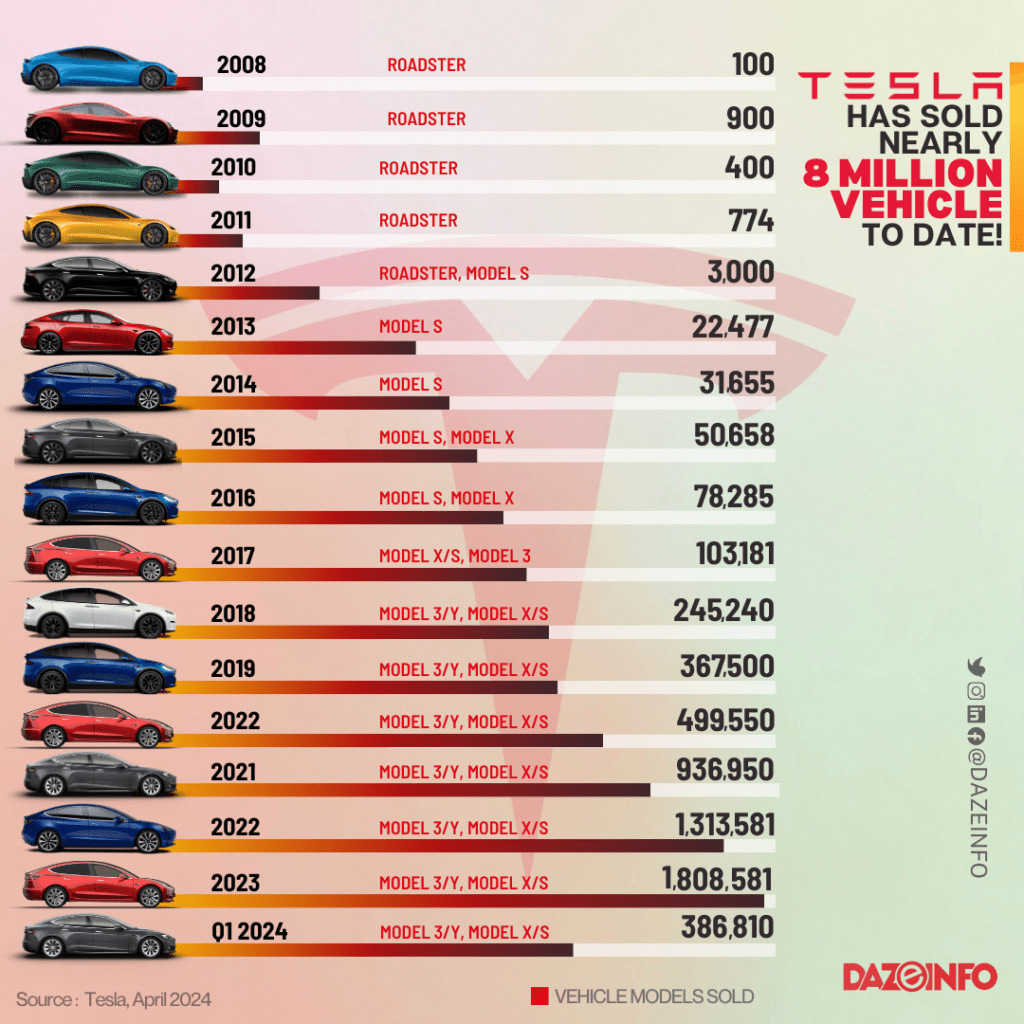Tesla has been struggling with the low demand for its electric vehicles (EVs), as evidenced by its first quarter 2024 earnings report. During this period, the EV company produced 433,371 vehicles with a 1.69% YoY decline and delivered 386,810 vehicles with an 8.53% YoY decline worldwide. The decline in volumes was partly attributed to the early phase of ramping up production of the updated Model 3 at Tesla’s Fremont factory, as well as factory shutdowns due to shipping disruptions caused by the Red Sea conflict and an arson attack at Gigafactory Berlin.
As a result, Tesla’s automotive revenue declined a notable 13% YoY to $17.38 billion in Q1 2024. A whopping 94.7% of its revenue came from vehicle sales, and the rest from leasing and regulatory credits. Compared to the fourth quarter of 2023, the total automotive revenue declined 19.41% YoY.
However, amidst these challenges, Tesla saw bright spots in its earnings report. Tesla’s global revenue from Services and other revenue increased an impressive 25% YoY in Q1 2024, while Energy generation and storage revenue increased a healthy 7% YoY.
Overall, Tesla’s worldwide revenue declined 8.69% YoY and 15.36% QoQ in Q1 2024, amounting to $21.3 billion.
Due to the surge in operating expenses (up 37% YoY), Tesla’s net profit dropped a massive 55% to $1.13 billion during the first quarter of 2024. It’s also a strong 85.76% QoQ decline from the $7.93 billion in profit generated in the holiday quarter of 2023.
The increased operating expenses were primarily fueled by investments in cutting-edge technologies like artificial intelligence, advancements in battery technology, and other ambitious research and development projects, including the costs associated with ramping up production of the Cybertruck.
Why Is Tesla Struggling with Low EV Demand
Let’s delve into why the demand for Tesla cars was in Q1 2024, affecting its revenue and profits worldwide. The underlying factor driving this shift is cost. The average selling price (ASP) of EVs has declined in the last few years, prompting consumers to opt for more budget-friendly EV options, such as those offered by BYD, Tesla’s primary competitor.
In Q1 2024, Tesla witnessed a 9% YoY decline in its EV car deliveries, whereas BYD reported a nearly 13% YoY increase in deliveries. However, this growth was significantly lower compared to the remarkable 85% YoY growth that BYD achieved in Q1 2023.
In Q1 2024, Tesla’s production of Model 3/Y experienced a modest decline of 2.13% YoY, totalling 412,376 units, while deliveries saw a more notable drop of 10.29% YoY, totalling 369,783 units. In contrast, production of other Tesla models increased by 8.02% YoY to 20,995 units, with deliveries soaring significantly by 59.21% YoY to 17,027 units during the same period.

Stiff Competition from China
Tesla is facing formidable competition from China, which dominated 60% of all EV sales in 2023, according to the International Energy Agency’s (IEA) Global Electric Vehicle Outlook 2024 report.
China’s strategy with electric vehicles diverges significantly from that of Europe and North America. China places a strong emphasis on producing smaller, more economical city cars that are specifically designed to directly compete with and even outperform equivalent internal combustion engine (ICE) vehicles.
In contrast, European and US automakers have predominantly focused on larger, luxurious, and higher-priced EV models, catering to a wealthier demographic of early technology adopters. This difference in approach reflects varying market preferences and priorities across different regions in the global electric vehicle industry.
To address the low demand for EV cars, Tesla is gearing up to produce more affordable, low-cost vehicles expected to debut around 2025. Elon Musk‘s mention of the “next generation” compact vehicle hints at a potential $25,000 entry-level EV. If Tesla achieves its 2025 production goal, this vehicle could become the most affordable EV in the US market, competing directly with budget EVs offered by rival automakers in other countries. Currently, Tesla sells a base Model 3 for $35,100.
Now, it would be interesting to see if Tesla’s affordable EV cars alone will solve the issue of low demand or if the company will need to devise alternative strategies to boost sales and expand its market presence.

